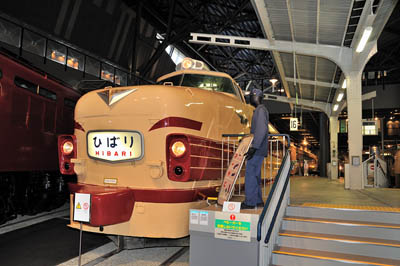
Electric Railcar
Class KuHa 481
|
First AC-DC Electric Car Series for the limited express train. (Ku = Driving car, Mo = Motor car, Ha = 2nd passenger class) |

|
|
The new DC electric limited express train "Kodama" was proven very popular since it started on the 1st of November 1958.
So, demand for the limited express services also increased to other lines. At the present time , Japan has three different electrification systems as shown on the map. If intercity limited express trains are to run on different electrification sections, these railcars, must each have, electrification converters.
JNR developed AC-DC dual commuter type Series-401 and 402 units, and express type Series-451 and 471 saw development during 1961-1962. Forming a basis for them, during 1963, JNR began the development of a multiple powered limited express model. Forty-one AC 60Hz - DC models, Series-481, were manufactured and saw service from Toyama during Hokuriku line's electrification during October 1964. Series-481 had the same appearance and good repute as the Series-151 "Kodama" model. Series-481 started limited express train service between Osaka and Toyama with the "Raicho (Grouse)" and Nagoya - Toyama's "Shirasagi (Egret)" on the 25th of December 1964. Fifty-six Series-481s, were increased in production, when Kumamoto, in Kyushu, saw electrification, during the year of 1965.
During October 1965, Morioka, on the Tohoku line, was completed with 50Hz AC power. At this time, forty-eight AC 50Hz version Series-483s were manufactured, and they saw service on the Ueno - Sendai train "Hibari (Lark)" and the Ueno - Morioka "Yamabiko (Mountain Echo)" on the Tohoku line.
When all Tohoku line electrification was completed during October 1968, AC 50Hz, AC 60Hz and DC triple mode electric Series-485 were manufactured. Triple powered Series-485s were enabled to see service on Japan's East and West electrified limited express sections. During October 1968, the first Series-485 saw service between Ueno and Aizu-Wakamatsu as the limited express "Aizu (A name of Western-Fukushima area)", " Yamabato (Turtledove) " between Ueno and Yamagata on the Tohoku line, "Midori (Green)" between Shin-Osaka and Oita on the Sanyo, Nippo line.
During 1975, Hokkaido's electric limited express "Ishikari (A county name in Hokkaido)" (Sapporo-Asahikawa) came on the scene for the first time with the Series-485. After that, the Series-485 saw continuous production and a total of 1,455 were produced by 1979. They were active on all parts of the electrified lines. The Series-485 with its large production, saw many variations. The early lead models had a Bonnet. During 1972 - 1973, the manufactured lead car had a box type body with a door for passage to other cars. Those manufactured during 1974 and 1976-1979 of the Hokkaido model, had snow and cold endurance equipment added to them. However, after Shinkansen network was expanded, main line limited express systems were gradually closed. The older cars were gradually retired and scrapped. But many Series-485s are still active on many of Japan's electrification lines at the present time. |
|
Preserved car No.KuHa481-26 (1965 - 2007)
The Museum Series-481, 2nd passenger class driving car, Class KuHa-481 No.26, was one of the first produced forty-eight cars. At this time, nine KuHa-481 driving cars (No.19-28) were manufactured. No.26 was manufactured at the Kisha-Seizo Co. on the 3rd of August 1965. And it's deployment was to the Sendai depot, it worked on the Tohoku line. On the 14th of March 1985, she was transferred to the Katsuta depot, and was active on the Joban line's train "Hitachi (An old name for Ibaragi prefecture)". On the 10th of July 2007, she was retired and was exhibited at the Railway Museum. |
|
|
Preserved car No.MoHa484-61 (1972 - 1991)
The no cab, motor car MoHa-481 No.61 was manufactured at the Hitachi Co. and was first deployed to the Sendai depot. Later, she was moved to the Aomori depot, and was active on the Tohoku line trains "Hibari" and "Yamabiko". On the 25th of November 1982, she was again transferred back to Sendai. Afterward, she was moved to Katsuta depot on the 9th of March 1985, and was used as the limited express train "Hitachi". During March 1991, MoHa481-61 was remodeled as a crew training car Class MoYa-484 No.2, and was continuously used for crew training operations at Katsuta. During July 2007, she was retired and restored to the original MoHa-481 in appearance, and was exhibited at the Museum.
|
Introduction |
Go to Top |